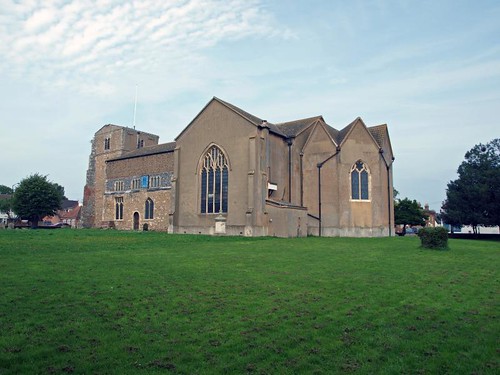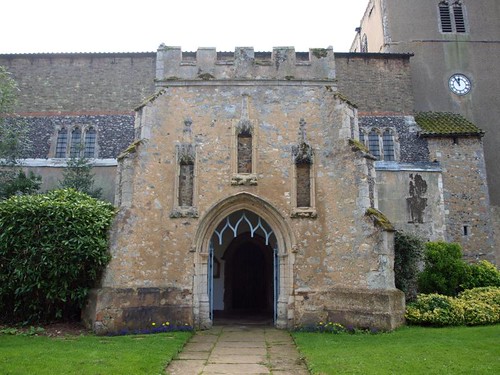The original church has had a hideous rendered chancel and south aisle tacked on to it - I've yet to see anything more inappropriate. The north porch is magnificent and very unEssex.
This is a curious mix of old and early brutalist architecture; despite my better judgement I really liked it.
I didn't particularly notice at the time or in the write up [I think it got lost in the general architectural absurdity] but the, in my experience, rare polygonal chancel, which is impossible to date is worthy of mention. I'd normally assume it was Victorian except that a similar chancel at Bluntisham is accredited to the C14th, so who knows?
ST LEONARD. A largish, odd, and aesthetically unsatisfactory church. The aesthetic failings are chiefly due to what was done about 1750 and in 1819. It is not quite clear which period did what. The result anyway is an extremely wide nave, the shape of an early C19 Methodist chapel with a yet wider crossing, transepts and a polygonal chancel. All this is covered by plaster rib-vaults of entirely unconvincing weight, a regrettable mistake in a church which possesses that rare thing in the county, a stone-vaulted S (sic) porch with a star-shaped tierceron-vault and bosses. It dates from the C15. The porch has two-light side windows and above the entrance three richly canopied and crocketed niches. The transepts and each of the three sides of the polygonal chancel carry a gable. An examination of the nave shows that it is of stone, was heightened in flint and yet more heightened in brick. The brick is C18 or C19, the flint with the clerestory windows C15; so the stone must be older. And indeed the S doorway turns out to be Norman. Norman also is the W window above the triple-chamfered C14 tower arch. The whole W tower is C14. It has one big diagonal buttress and flint-and-stone-ornamented battlements. - FONT. Perp, octagonal, with decorated foot, stem and bowl. The ornament is chiefly the usual quatrefoils. - BENCH-ENDS. Two, of the C15, with poppy-heads, in the chancel. - PLATE. Cup of 1568 with band of ornament. - BRASSES. Man and wife c. 1560; J. King d. 1634 (both chancel floor).
SOUTHMINSTER. It has far-back memories, and Roman bricks in its Norman walls, but it is not of this that we think when Southminster comes to mind. It is of something nearer to our time, something which must interest every bride and bridegroom married here. They sign the register leaning over the very table on which Nelson leaned poring over his charts on the eve of Trafalgar. Here is not only the chart table from the Victory but a bureau which Nelson used and a mirror into which he must have looked. They are here because it was to this place that Alexander Scott, Nelson’s chaplain on the Victory, his personal secretary and his friend, came as vicar after the Battle of Trafalgar. He brought these things with him and gave them to his church. He was one of the four or five men we have come upon in our journeyings who were with Nelson when he died. He was at the side of Admiral Parker on that day when Nelson refused to see the admiral’s signal, putting his blind eye to the telescope; greatly did Scott enjoy the joke of the “audacious little fellow.” It was to Dr Scott that the dying Nelson whispered, “Thank God I have done my duty,” and it was Scott who watched night and day by his body as it lay in state in the Painted Hall at Greenwich, and who wrote to Lady Hamilton:
Here lies Bayard, but Bayard Victorious, so help me God, I think he was a true knight and worthy the Age of Chivalry.
Dr Scott loved the quaint town in which he made his home after his exciting life at sea. It has overhanging roofs in its narrow streets, a timbered 17th century manor, and the tang of the sea wafted to it across Dengie Peninsula. He rebuilt the chancel and set a sundial on the walls to keep company with two mass dials of long ago. He persuaded the Southminster people to raise funds to help the families of those who fell with Nelson at Trafalgar, and framed lists of their names which still hang in the vestry.
The tower was set up by the Normans and there is a Norman doorway and Norman windows. Craftsmen of medieval England gave the church rich carving on canopies and niches and in the elaborate panels of the font; and it was in the 15th century that the walls were raised for the clerestory windows. There is a 15th century door into a room over the porch, an ironbound chest of the 16th century, and a brass portrait of John King, a civilian of Charles Stuart’s day.
Here lies Bayard, but Bayard Victorious, so help me God, I think he was a true knight and worthy the Age of Chivalry.
Dr Scott loved the quaint town in which he made his home after his exciting life at sea. It has overhanging roofs in its narrow streets, a timbered 17th century manor, and the tang of the sea wafted to it across Dengie Peninsula. He rebuilt the chancel and set a sundial on the walls to keep company with two mass dials of long ago. He persuaded the Southminster people to raise funds to help the families of those who fell with Nelson at Trafalgar, and framed lists of their names which still hang in the vestry.
The tower was set up by the Normans and there is a Norman doorway and Norman windows. Craftsmen of medieval England gave the church rich carving on canopies and niches and in the elaborate panels of the font; and it was in the 15th century that the walls were raised for the clerestory windows. There is a 15th century door into a room over the porch, an ironbound chest of the 16th century, and a brass portrait of John King, a civilian of Charles Stuart’s day.



No comments:
Post a Comment